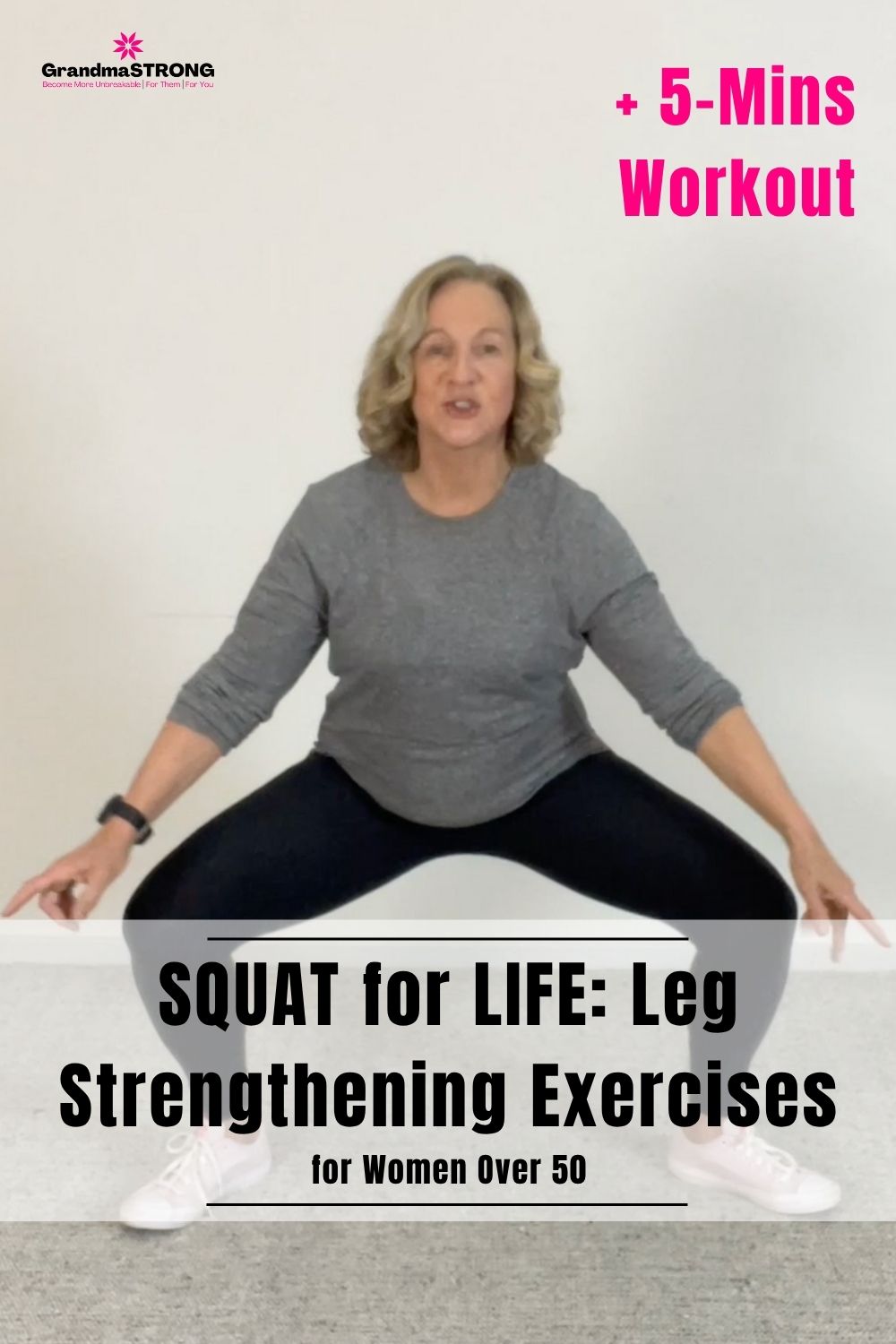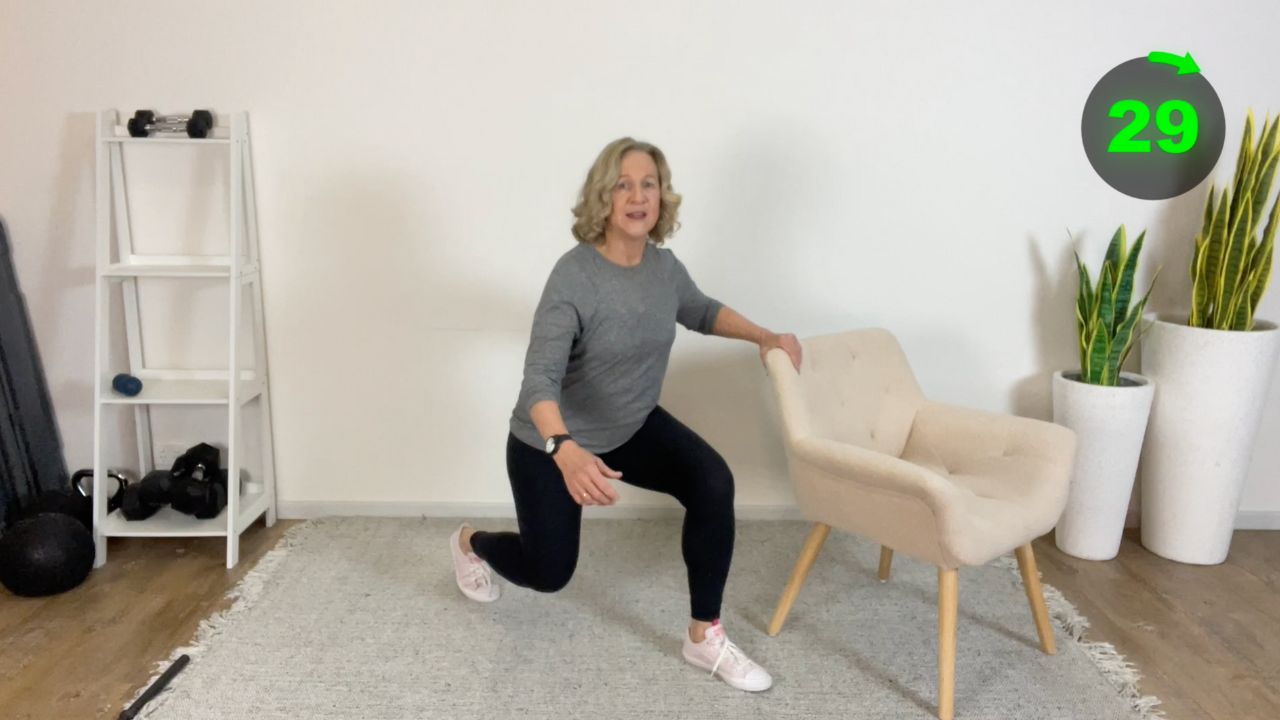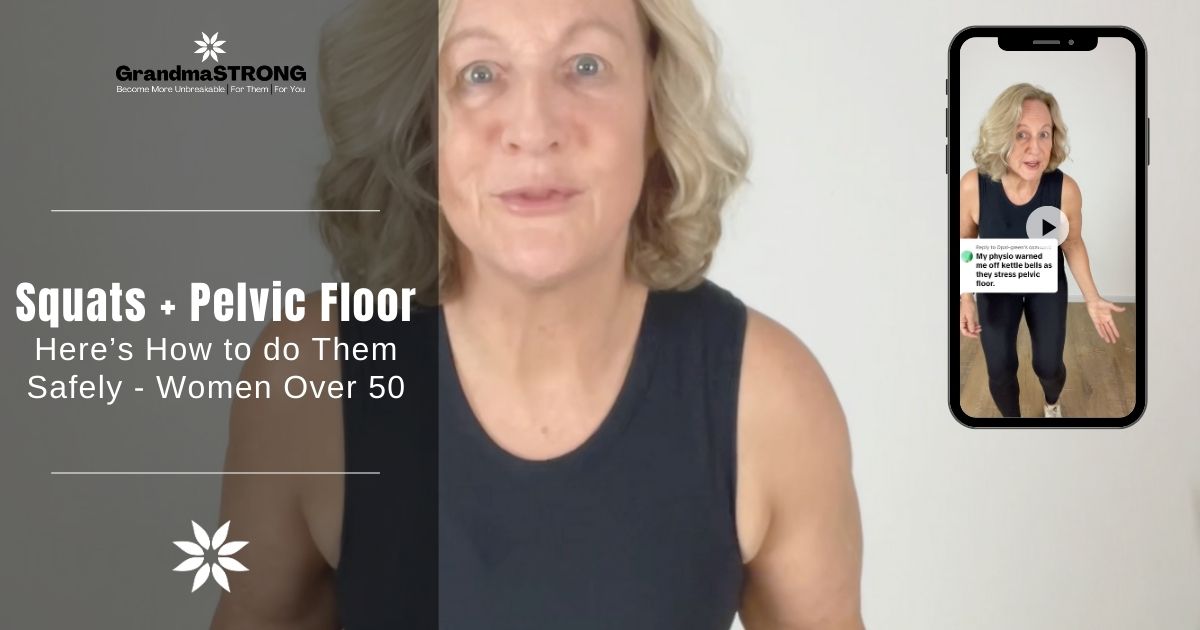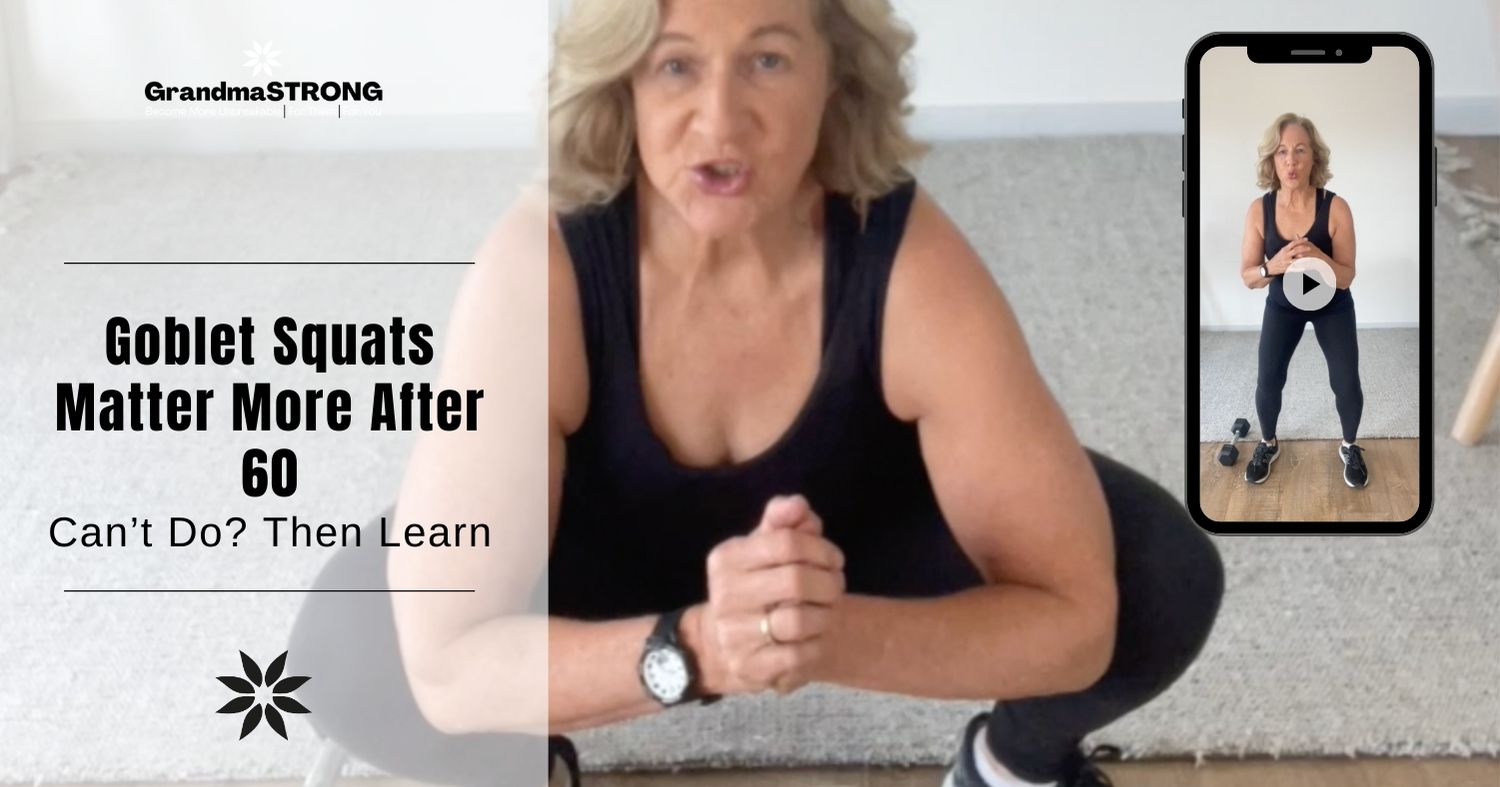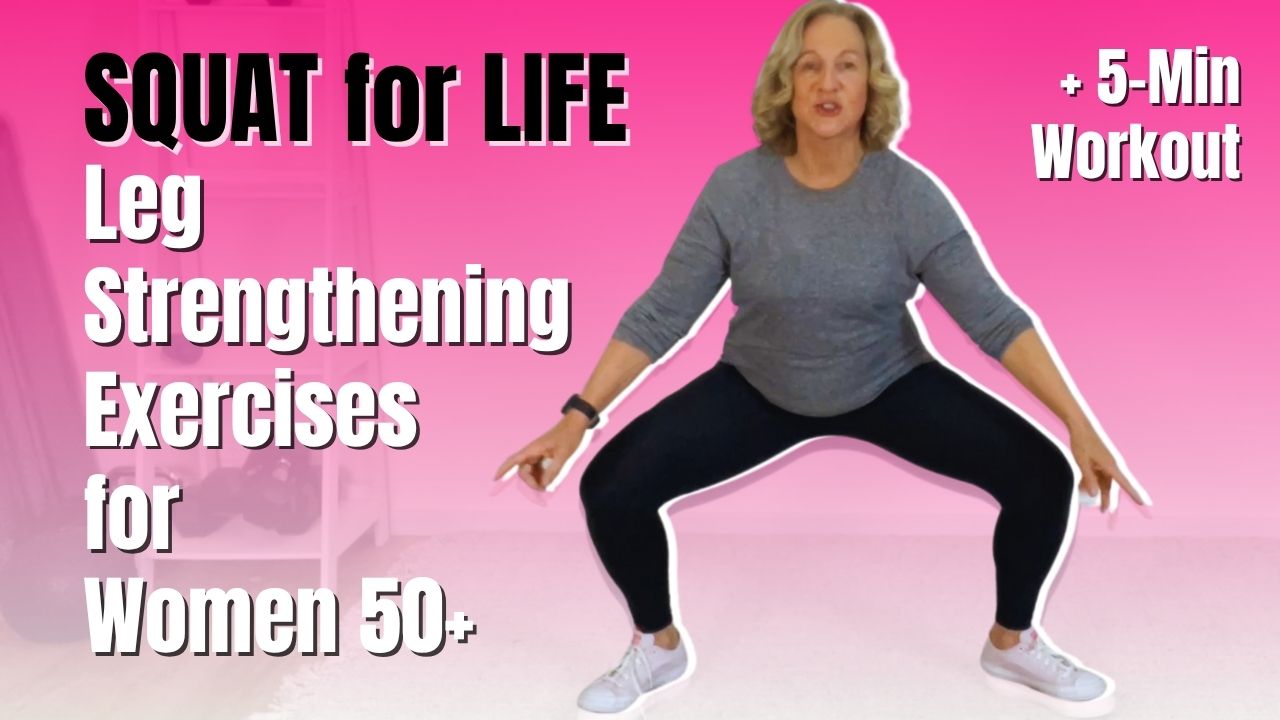
Hi there, it's Coach Sheree, I'm just wondering if you can still squat down with confidence and get back up without the knees caving in and ankles rolling in too much.
Sometimes we get so much knee pain when that happens. I had a client who was referred to me a little while ago because her knees were so sore.
She'd been squatting every single day for 20 years without fail. And it's no wonder her knees were sore because her squat technique was awful. She was coming forward onto the balls of her feet and her whole body weight was on those knees. Mine would be sore as well if I did that.
In this post, we're diving into why squatting is one of the most essential movements for women over 50, then I'll walk you through a couple of simple moves you can start doing right now to improve it, and finish with a five-minute squat-based workout (that you can put on repeat) you can do at home, no equipment needed.
So let's get grandma strong, one squat at a time.
Watch: Leg & Glute Strength After 50: Safe Squat Variations for Women at Home (16mins)
Press play or keep reading, either way, you’ll master this essential ADL move in under 15 minutes.
Ready, let's jump into the 'SQUAT for LIFE: Leg-Strengthening Exercises for Women 50+' lesson:
So, in this post along with the why, you'll learn some key trunk twisting exercises with a band and fit ball you can do at home, and then we'll wrap up with a simple five-minute at-home workout that keeps you moving well and pain-free.
Why Maintaining Your Ability to Squat for Life Matters:
Now, you may say to me that your leg strength is great as you use a machine such as a leg press at the gym, but this has little functional carryover into our everyday lives where we use many other muscles, simultaneously just to maintain balance. Meaning, we strengthen our squat in the same way we do it in everyday life.
So, I'm going to show you what affects your squat in real-life, like stiff hips, cranky knees, and why the squatting movement pattern is so important?
Let's unpack four everyday scenarios as you age through your 50s, 60s and beyond.
1. Getting up and down without asking for help or needing assisted aids
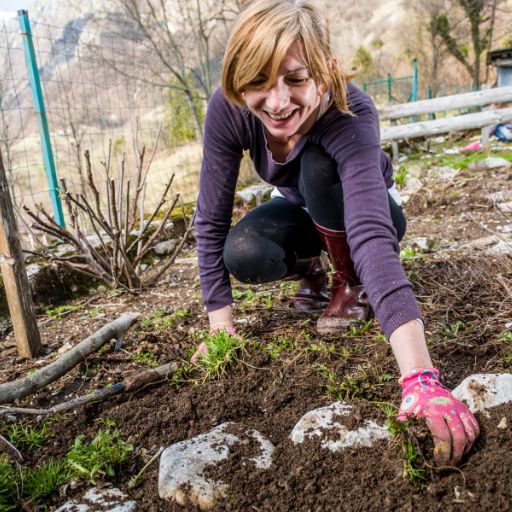
So, picture this, you're pulling weeds while squatting for 10, 30 or 60 minutes, and as you start to stand up from that split-squat position, you're now looking for anything that will help you as your legs can't do it smoothly and without any jolting knee pain.
Or, more embarrassingly, after shopping and your legs are already fatiguing, you go to the toilet, no hand rails to help you get up, and you need to call for help.
If you can squat properly and without pain, your glutes and quads will be able to lift you straight up whenever you want, giving you the priceless gift of privacy and freedom of movement and independence, for lives everyday tasks.
2. Carrying life's valuable (and wriggly) goods

Things like grandkids, plants, and food bags all need to be lifted from the ground to the hip level. Your lower body works like a crane when you do a safe squat.
If you've learnt to squat and lift well, that load will stay close, your back will be tall, and you'll have your knees aligned over your feet.
In other words, you don't get that sharp "oh-no" in your lower back or knees when you pick up a laughing child. The better your squat, the longer you'll getting down on the floor with grandkids, and maintain the independence to garden, and shop when you want or need to.
3. Taking care of your joints over time
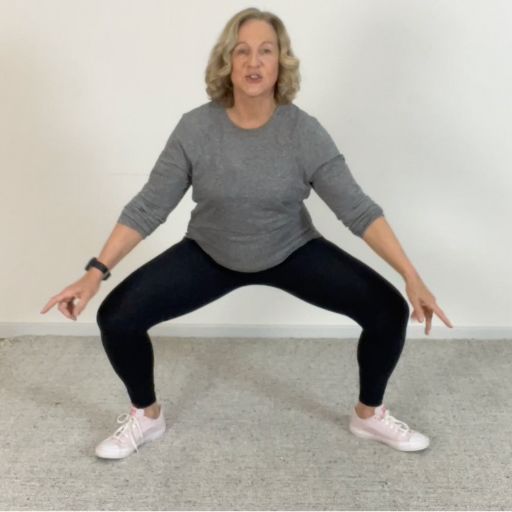
When you have learnt to squat smart, your hips, knees, and feet learn to work together instead of putting all the stress on one joint, because you're squatting with control, keeping your heels down and your knees in line with your toes.
So, that even load shared from hips to feet, keeps the cartilage (knee particularly) healthy, feeds the synovial fluid (that's like WD-40 for your knees), and builds the muscle cushion that keeps the bones from pressing against each other.
And, that means fewer cortisone shots, less "stair dread," and more years of pain-free adventures, like hiking in the mountains, or just chasing a toddler down the hall who got away.
4. Protecting against falls and broken bones
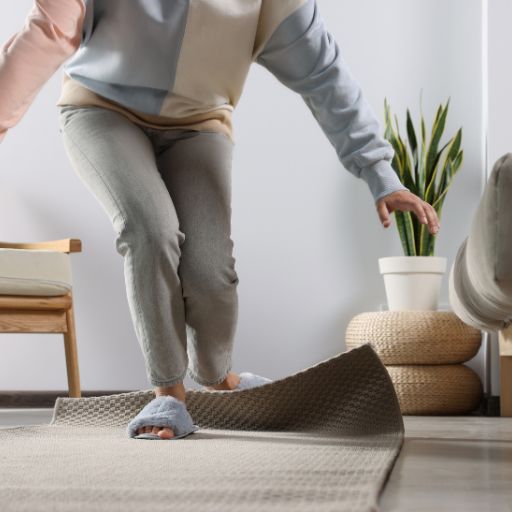
This one is "BIG" as strong, flexible squatting isn't just a cool gym move, it's a safety feature that keeps you from falling.
See, when you trip, your body learns to turn and adjust at the hips, respond to changes in balance, and fire those quick-twitch stabilisers that catch you when on uneven surfaces.
Then, when you add in the benefits for bone loading in the knees, femurs, and spine, you have everything you need to boost bone density (ie. stronger bones).
So, when lives adventures gives you a slip, trip, or uneven bush track out of the blue, your legs will say, "I got this."
Exercises #1: Basic Squat Technique
So we're just going to go through a bit of the squat technique today. If I ask someone to do a squat, they may say to me, I don't know how to do a squat. I've never done a squat. But the fact is that when you sit down and up in a chair, this is a squat.


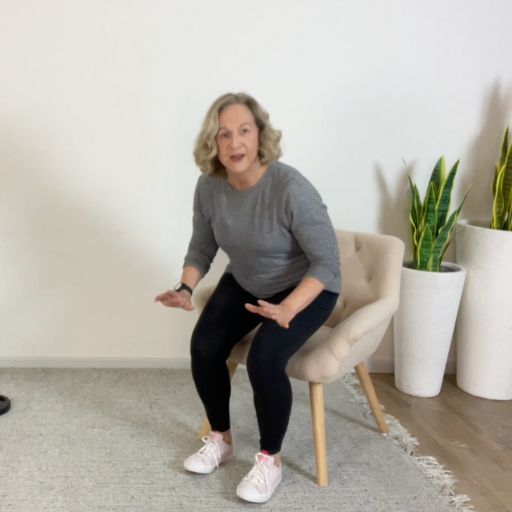

- We sit back, knees bent, bottom out, and lower down into the chair. So it's a bit of a lean forward. We pop our bottom back in the chair
- Then we push the ground away from our heels and we stand straight up. Again, we lean forward sitting in the chair and coming up, push the heels away. So that is the same as a freestanding squat
But today, I'm just going to do a freestanding squat.
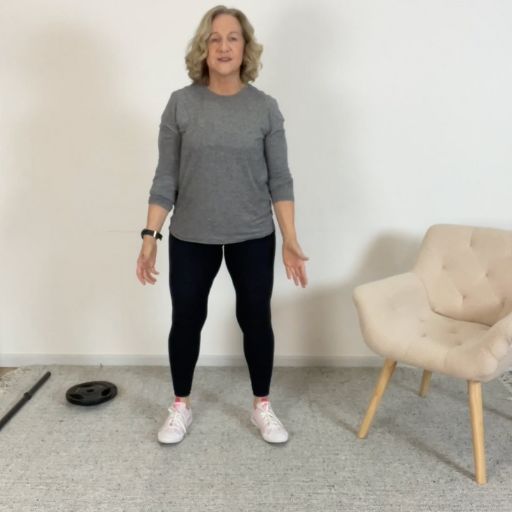
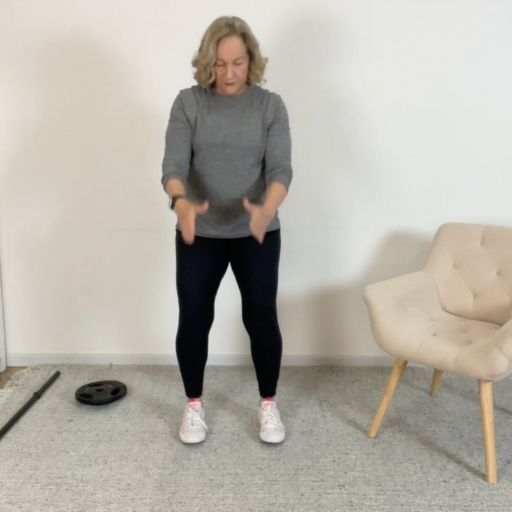
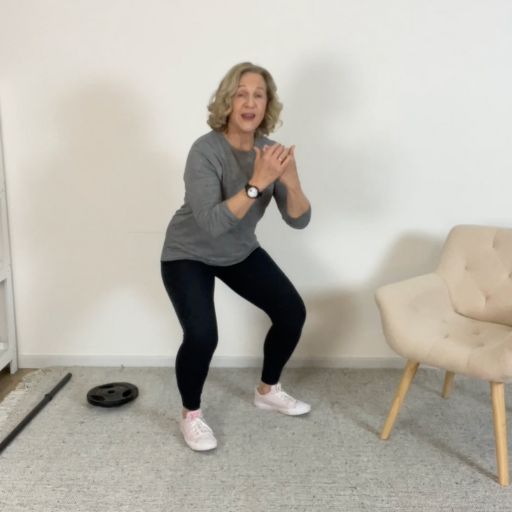
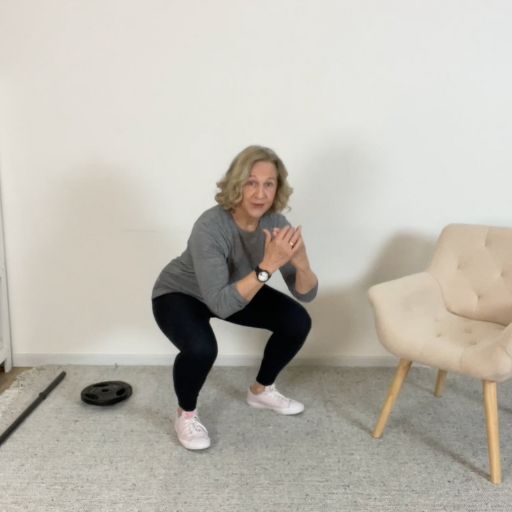
- So I'm going to take my feet out to about 30 degrees
- NOTE: A number of people say you need to have your feet going front, but you don't. Whichever way they go, your knees will go the same way
- So just think about as we're going to lower ourself down, we're going to look at the horizon about the horizon. So straight ahead or 10 degrees ahead above that
- And we're going to keep that chest high and I'm going to keep my feet there. So I'm going to press my weight into the heel
- And as I come down, I'm going to take a breath in, pull my belly button into my spine, and then I'm going to go down.
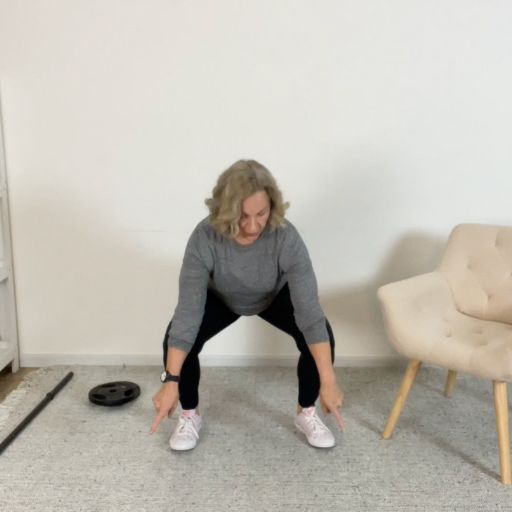
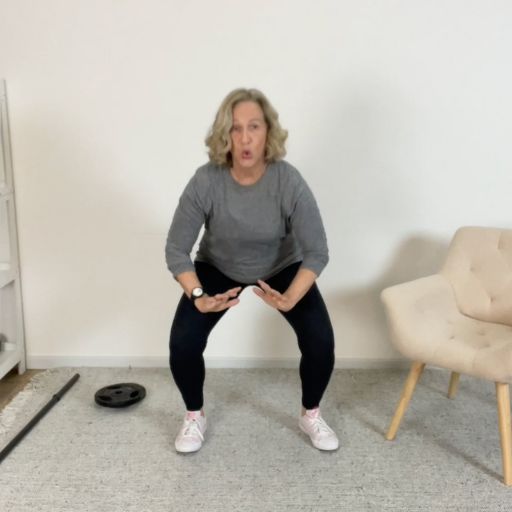
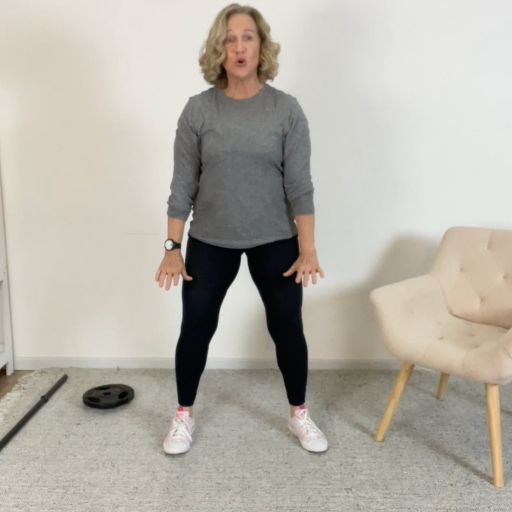
- Now, when I'm down here, I need to have my knees over the second toe of my foot
- And as I come up, I'm going to breathe out and push my heels away from the ground, like I'm trying to push the ground away from me.
- So TRY just going down as low as is comfortable, inhale, come down. Knees are facing the second toe and pushing the ground away, come straight back up.

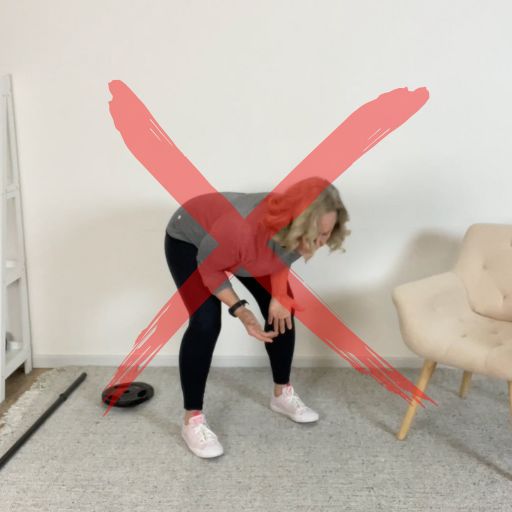
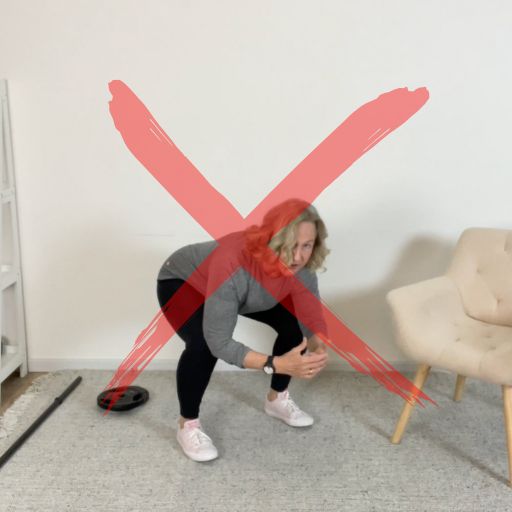
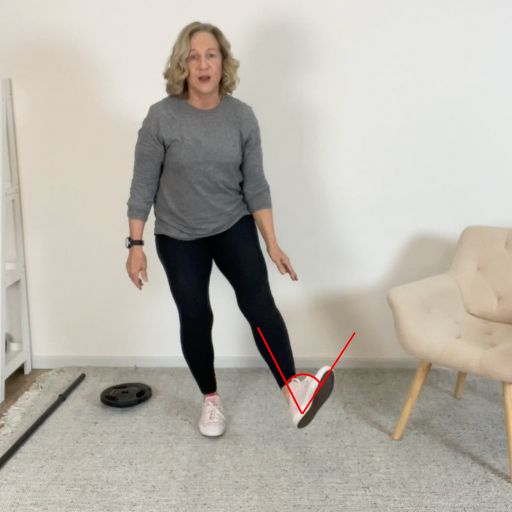
- There's a different types of squats we can do. We can come down into a low, low goblet or deep squat.
- But for some of you, quite a few of you, that may not work for your knees.
- Now there are some reasons that people will come down and not be able to get down low, like a deep squat.
- They'll bend right forward to come down in a squat.
- You may be really tight in your ankles, so you don't have enough of the flexion, the dorsiflexion to bring that foot up
So let's look at compensating that with some elevating of your heels slightly
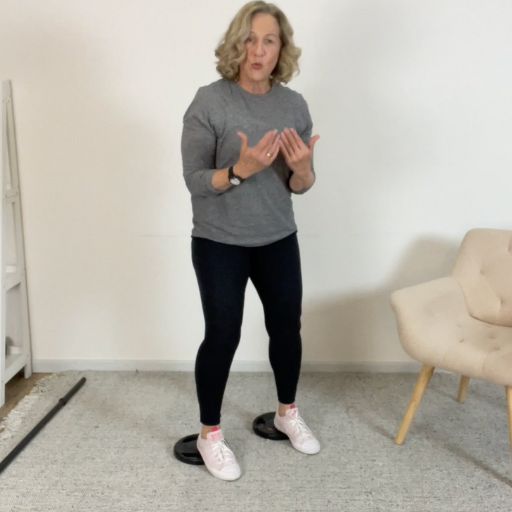
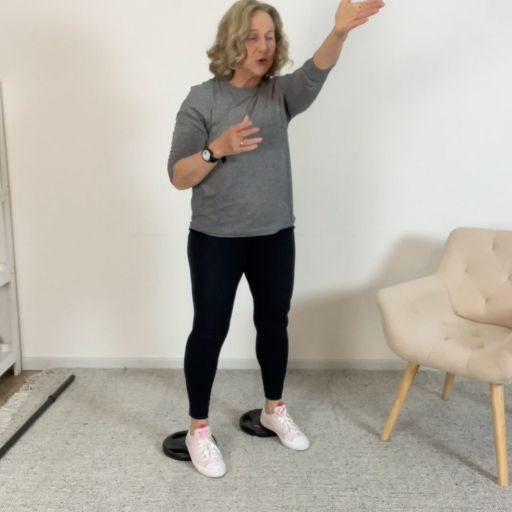
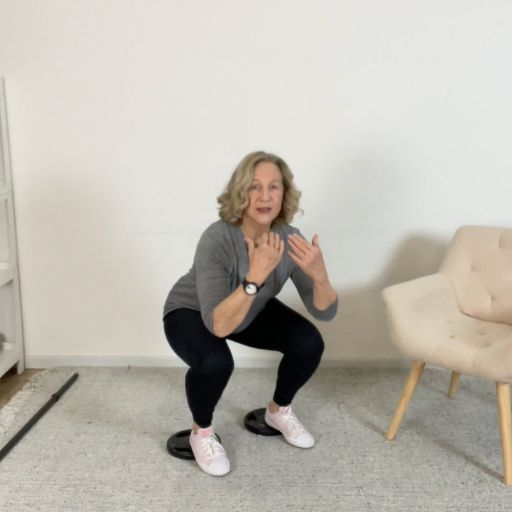
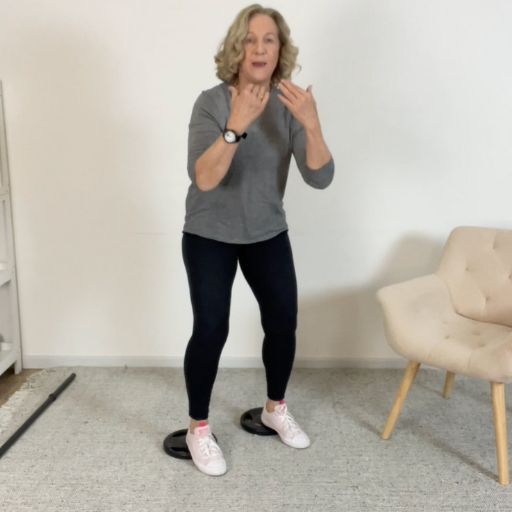
- I'm going to put my heels on these and that will make it easier for many people who are really tight and cannot get that flexibility to be able to come down and still keep their chest up nice and high
- So same things apply, looking at the horizon, just trying to
- Drop down, bring those hips down, like we're trying to sit on a low chair behind us
- And then we come up, press up through the heels.
Exercises #2: Broom Assisted Squat
So we're just going to be looking at a dowel-assisted squat.
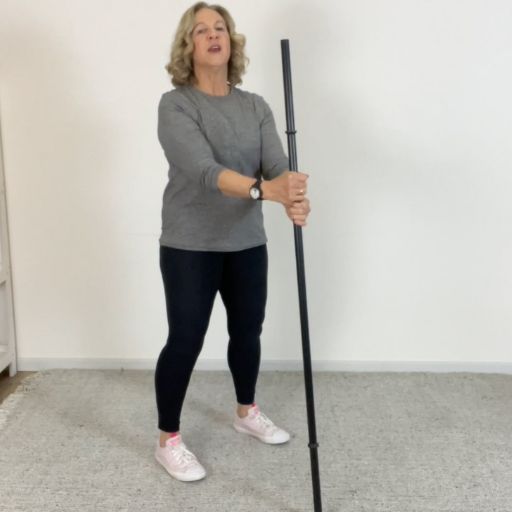
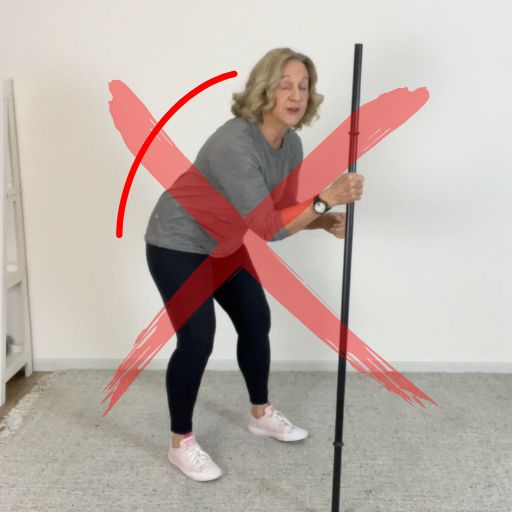
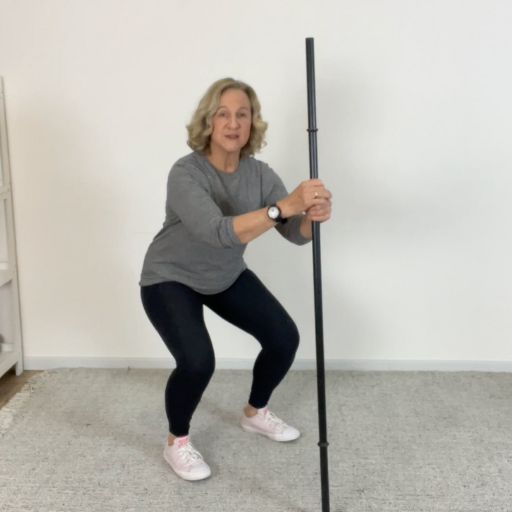
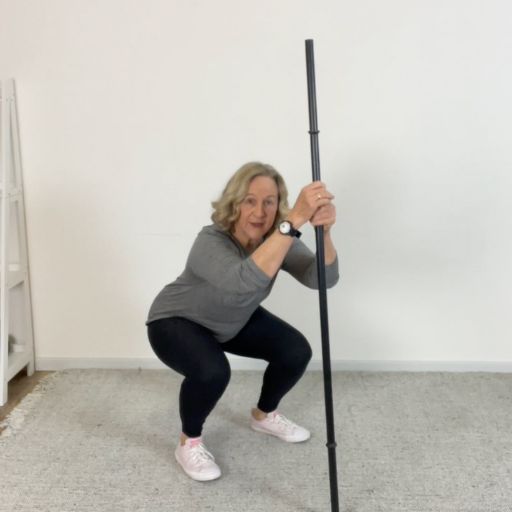
- So we're going to hold this just above the hips, nice relaxed arms, and it's basically the same things we're going to be doing, looking at the horizon 10 degrees above
- We're going to make sure that we keep that back and don't round out the back as we go down
- We're going to take a breath in, pull the belly button in, and then we're going to be coming down and then holding for a moment and then making sure our knees track over the second toe and exhale as we come up
- So inhale, look at the horizon, pull the belly button in, coming down and then coming back up.
Exercises #3: Split-Squat (Single Leg)
Let's look at a split squat here.
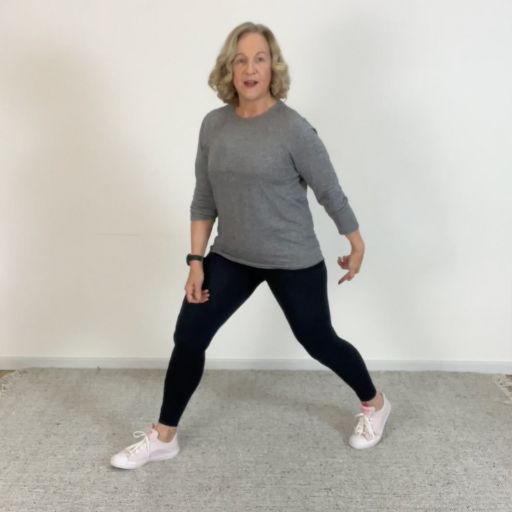
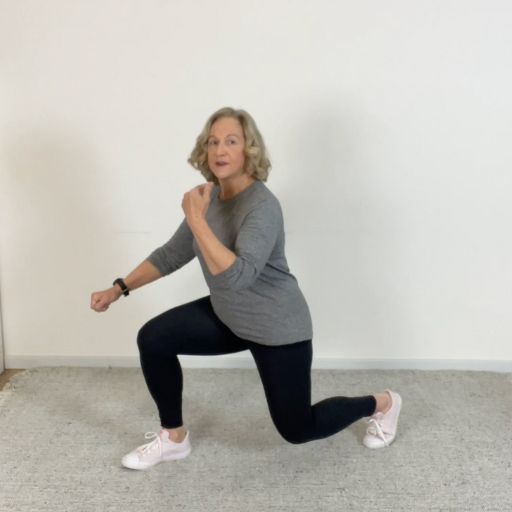
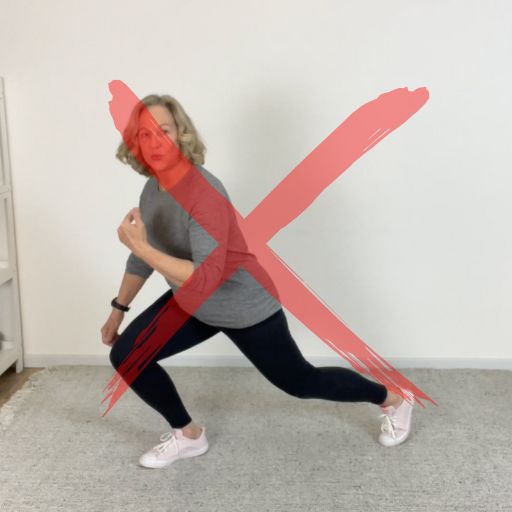
- So we're going to be taking a big step out, the heel is up at the back, this leg at the front is the one doing the work, and our pelvis is between both feet
- So as we go down and up, we're going to just sink straight down and then straight up
- NOTE: If you want to take, lift those toes in front of that front shoe, that'll activate the glutes a bit more in that front leg
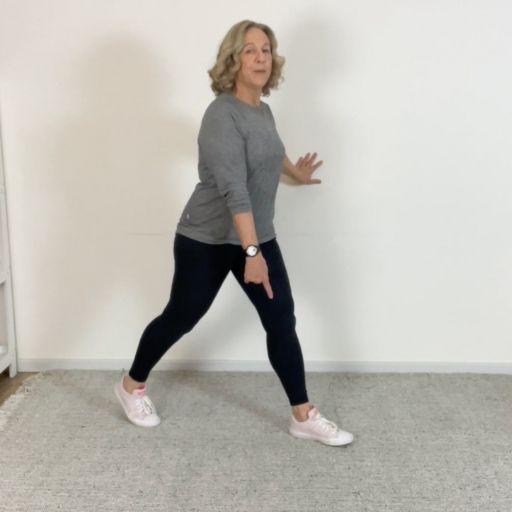
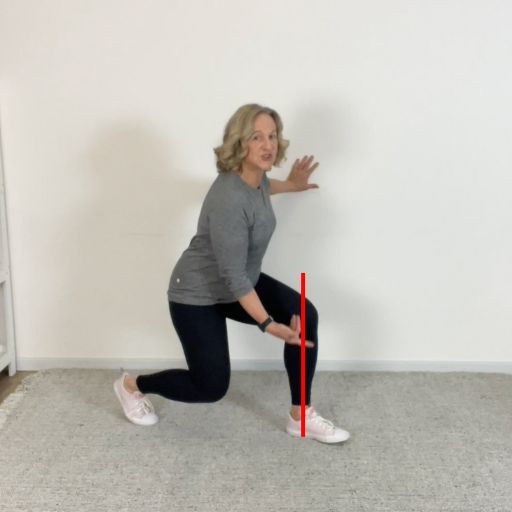
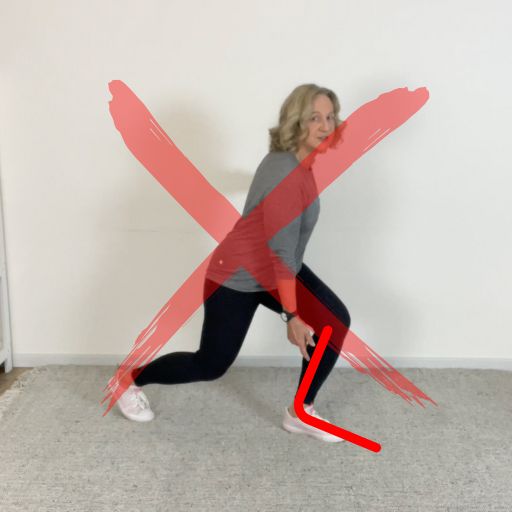
- If you feel unstable with that, feel free to hold onto a wall and coming down and up
- This front shin is staying straight
- So what we don't want is you to lean right over with our knee
Exercises #4: Wide-Stance Squat
Another type of a squat we can do, and this is particularly good for those with sore knees, is a wider squat. It will be all the same things, we're looking ahead at the horizon, trying to keep that chest up, but this wider squat takes into account a lot more of our adductors, the inner thighs, and so it can be a lot kinder for people with sore knees.
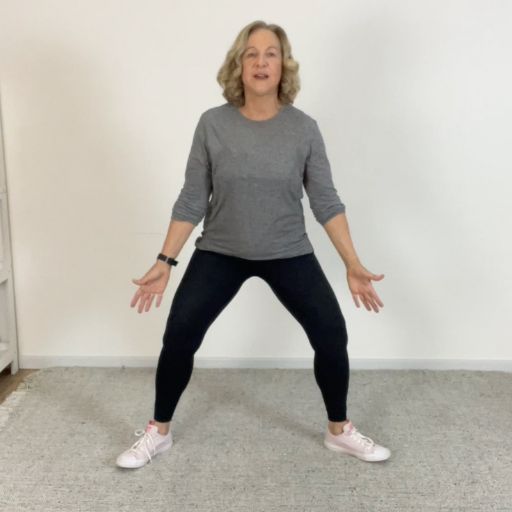
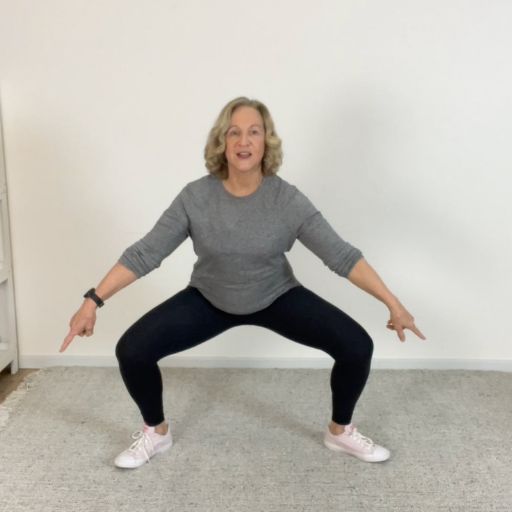
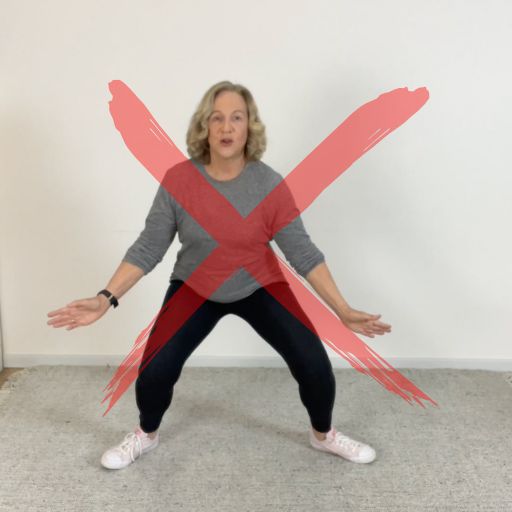
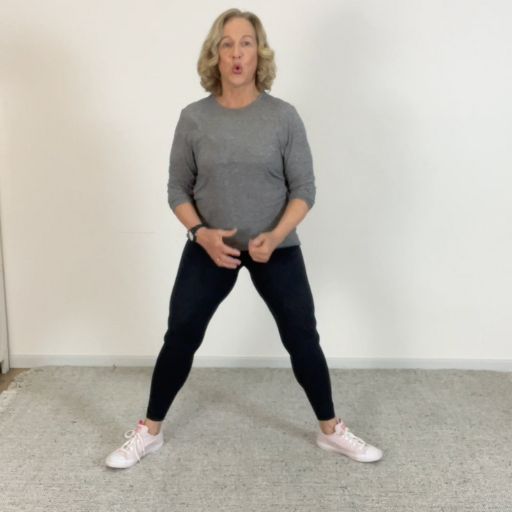
- And so with the same thing, we'll breathe in, a little bit of a pull in from the belly button, we'll look ahead at the horizon, we'll take ourselves down
- These knees will still track over the second toe
- Because those knees don't want to be caving in, but tracking out
- And then coming up again. Inhaling in, we're going to come down, knees track over the second toe, keeping that chest up, and taking it up.
(Stiff Ankles - Knee Pain - Squat) Correlation & FIX
Now, the squat is an 'All of Leg Movement,' IE. hip-to-knee-to-ankle. So the knock on affect of having stiff ankles is significant, as our knees and hips will compensate, thereby causing un-necessary strain, leading to compromised technique.
So many of us will have sore knees (limiting our squatting) because our ankles don't work.
So, if we've got stiff ankles, we can start to walk. And if you're sitting a lot during the day, start to walk on a flat surface, and when that becomes easy enough, start to walk up and down hills.
I often say to people, if you live on a hill, that's perfect, because a hill gives you a great workout opportunity, and ankle flexibility, so that dorsiflexion improves in that foot.
Now, even more than that, if you're finding that's okay for you, head out into the bush, head out to uneven terrain where you have to negotiate rocks and boulders and all sorts of things, because that will make the ankle go into all sorts of different moves. Forward, back, side ways, it's going to make that ankle work. So it's not going to be so stiff anymore.
Now, let's look at some ways that you can actually just un-tighten around that ankle at home, without the walk.
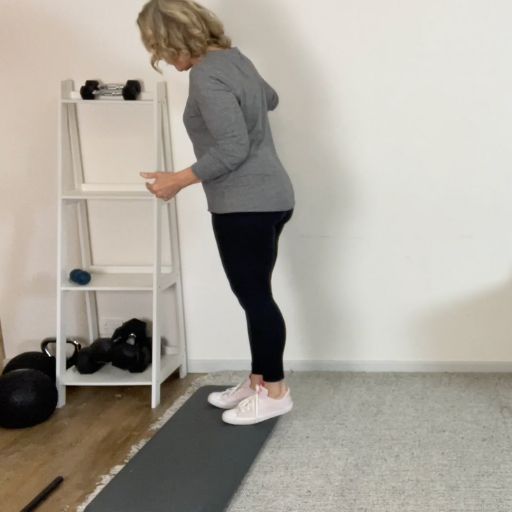
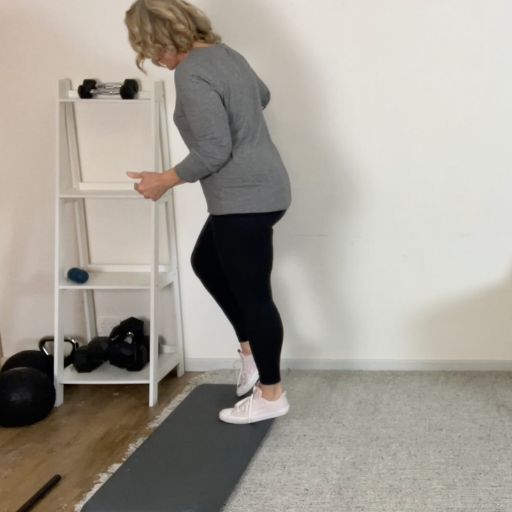
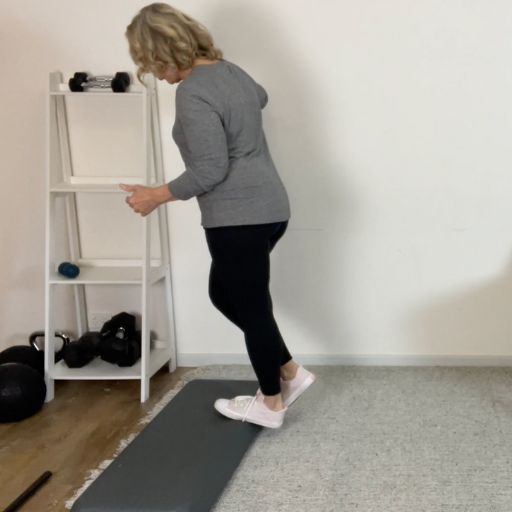
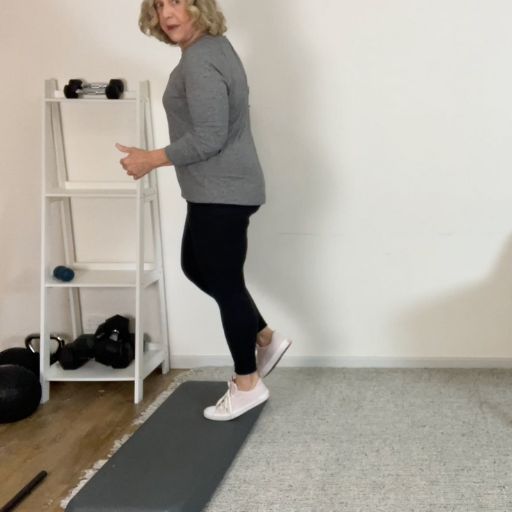
- You can have a step, it might be a step outside. We're going to do a single leg
- So I'm going to put the ball of my foot on the step, and I'm just going to let my heel
- Now, if you need to have that other toe on the step to balance you that's OK, but otherwise holding onto a wall
- That heel is going to come down as low as it can to the floor
- And then coming up high
This ankle stretch is going to give me some more movement into that ankle and stretch out my calf at the same time.
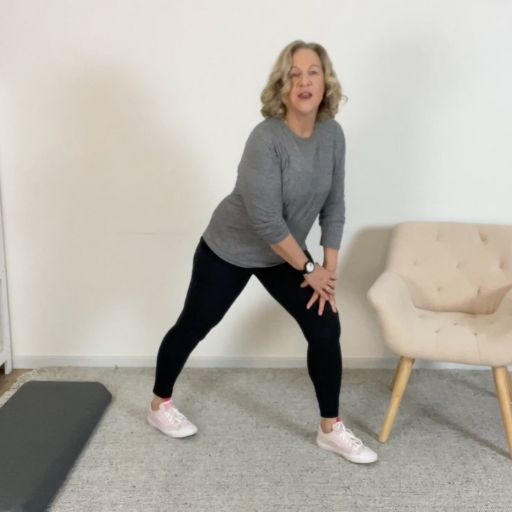
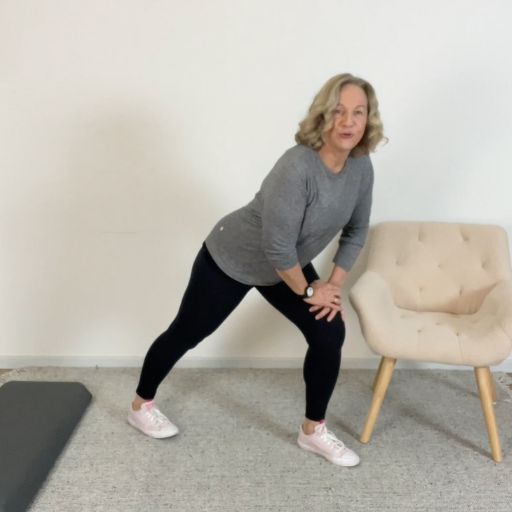
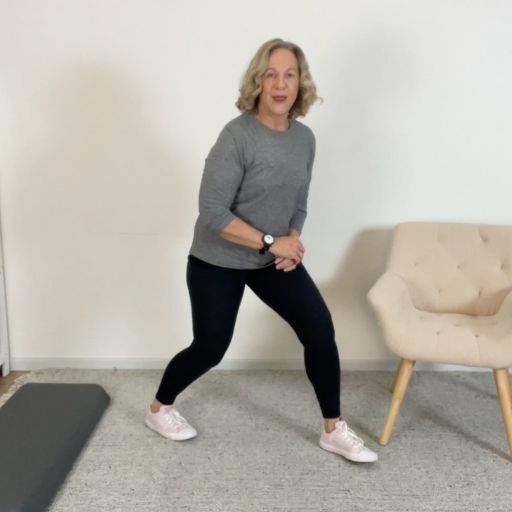
- You can be doing a upper calf stretch here where we've got our heel down and we lean forward into that
- So now I can feel my gastrocnemius, the upper part of my calf is having a nice stretch
- And if I simply bend that back knee, I can feel that stretch going down into my lower calf
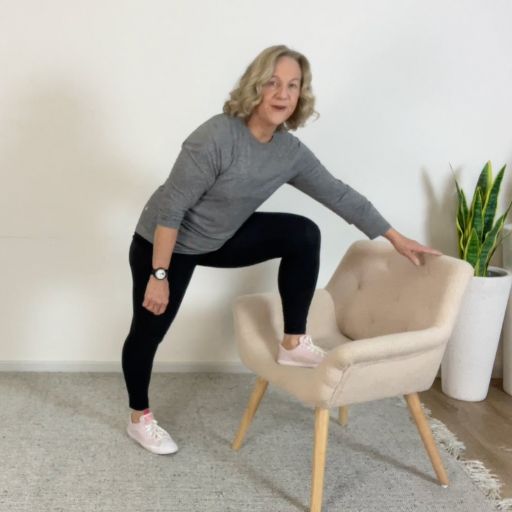
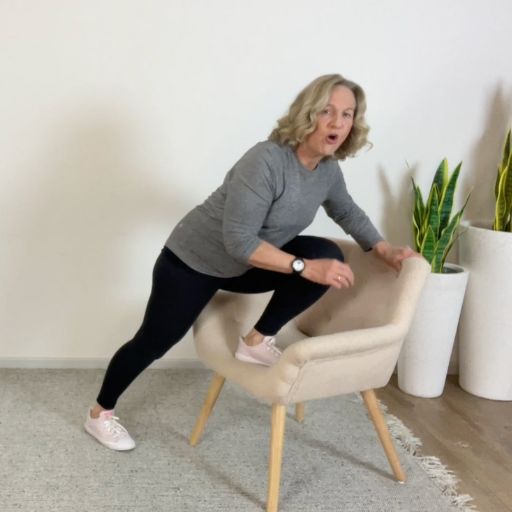
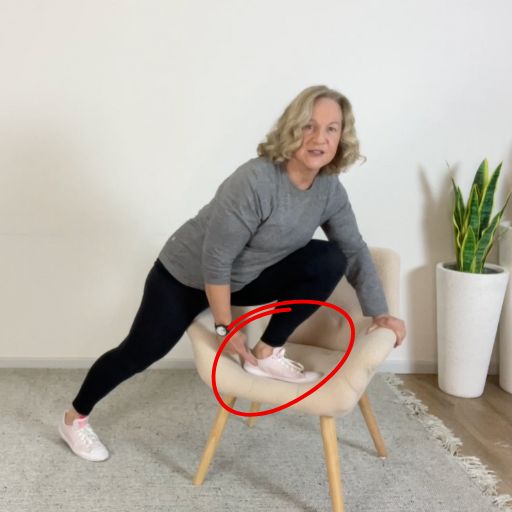
- I'm going to bring up my foot. It can be on a chair or a step
- And I'm going to come as far forward as I can into that. So my whole body weight is going to lean right over that knee
- And I'm getting a great, if you can see my foot here, I'm getting a great dorsiflexion into this foot
Workout: 5-Minute Repeatable Routine
Enjoy this squat strengthening workout, that Coach Sheree has put together, to compliment this SQUAT for LIFE: Leg Strengthening Exercises for Women 50+ post.
For a WARM-UP do some on the spot marching, with arms moving/swinging for 2-3 minutes before you start the workout. The warn-up intent is to simply get the blood flowing across your body and muscles.
This squat strengthening workout has been designed for those who that struggle with everyday squatting movements, and know they need to gain the strength and mobility to the gain freedom and independence they desire.
NOTE: This is a Bodyweight workout, if you'd like to add some weight, take note of the dot points below.
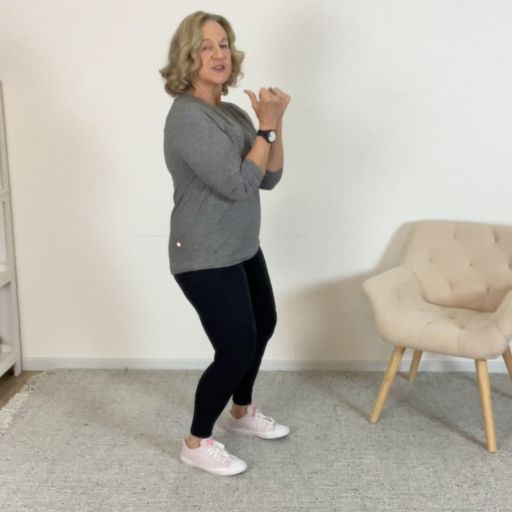
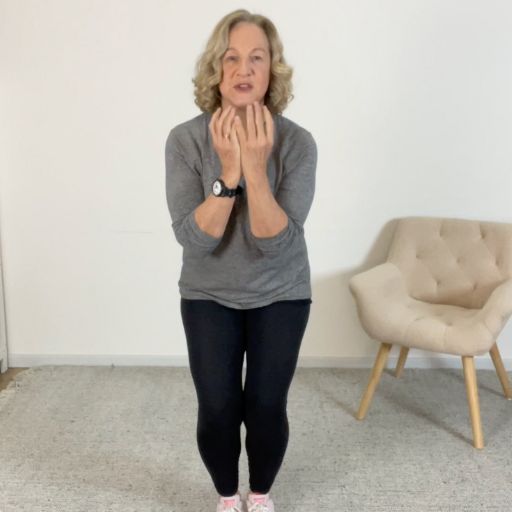
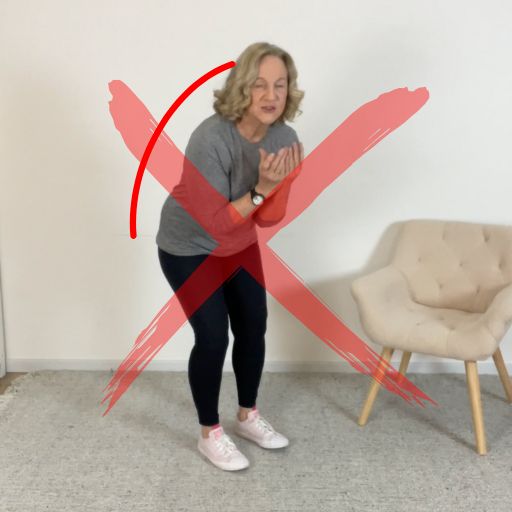
- We don't need any equipment with this, but if you did want to hold a weight in the front
- You would have your elbows in by your ribs and holding that weight in nice and tightly in here. So we support that weight in front
- Making sure that that weight does not pull you forward
Workout timestamps:
Timer 30 seconds workout and 10 seconds rest between.
09:38 - Basic Free-standing Squat
- Description: Hips go back like sitting in a chair, feet slightly turned out, chest up, push through heels.
- Real-Life Gain: Sitting and standing confidently, from the toilet, car seat, or low chair.
- Body Strength Gain: Builds quad, glute, and core strength while training balance and ankle control.
10:28 - Wide-Leg Squat
- Description: Feet wider than hips, knees track over toes, upright chest.
- Real-Life Gain: Safer squatting for those with knee pain or inner thigh tightness.
- Body Strength Gain: Activates glutes and adductors (inner thighs), supports hip stability.
10:59 - Wide-Leg Pulse Squat
- Description: Stay low in wide stance, small up/down pulses
- Real-Life Gain: Mimics staying low while gardening, crouching, or lifting from the ground.
- Body Strength Gain: Builds endurance in quads and glutes, especially adductors.
11:30 - Split Squat
- Description: One foot in front, back heel up, drop straight down, core braced.
- Real-Life Gain: Prepares you for climbing stairs, getting into the car, or rising from a kneel.
- Body Strength Gain: Strengthens front-leg glute and quad, challenges balance and ankle stability.
12:42 - Wall Squat Hold
- Description: Lean against wall, slide down into a squat hold, time under tension.
- Real-Life Gain: Simulates hovering in public toilets or during outdoor tasks.
- Body Strength Gain: Builds static endurance in thighs and glutes, strengthens joint support systems.
13:27 - Calf Raise Squat (Optional Jump Squat)
- Description: Rise onto toes or soft jump from squat, land quietly.
- Real-Life Gain: Builds foot control and quick-response ability to catch balance on uneven ground.
- Body Strength Gain: Strengthens calves and foot/ankle complex, enhances joint reactivity and springiness.
14:33 - Assisted One-Legged Squat
- Description: Use chair or dowel, perform single-leg squat or toe-tap to build strength.
- Real-Life Gain: Helps with getting up from the floor or stair climbing when one side is weaker.
- Body Strength Gain: Targets glute max, quad, and stabilisers deeply on one side.
16:13 - Deep Goblet Squat (Asian Squat Hold)
- Description: Drop low into full squat (hold onto dowel if needed), heels flat, chest lifted.
- Real-Life Gain: Mimics crouching down to child level, or reaching low cupboards without strain.
- Body Strength Gain: Trains deep mobility in hips and ankles, builds lower glute and adductor strength.
Final Thoughts
I hope you've enjoyed these squatting exercises, and workout. Let me know in the comments if you found that helpful or what you would like more of.
Thanks for joining me. See you next time.
Additional SQUAT Related Post/Video Resources: CLICK Image/Link:
